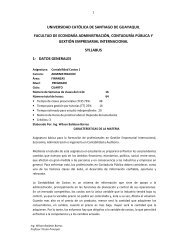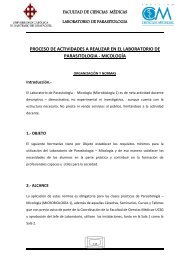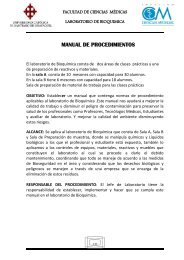el simbolismo médico: la lucha eterna - 201 - Universidad Católica ...
el simbolismo médico: la lucha eterna - 201 - Universidad Católica ...
el simbolismo médico: la lucha eterna - 201 - Universidad Católica ...
You also want an ePaper? Increase the reach of your titles
YUMPU automatically turns print PDFs into web optimized ePapers that Google loves.
Rev. Med. FCM-UCSG. Año <strong>201</strong>0. Vol. 16 N°3. Págs. 196-202<br />
ISSN 1390-0218<br />
Reacción en cadena de <strong>la</strong> polimerasa vs. serología en <strong>el</strong><br />
Screening de citomegalovirus en mujeres embarazadas y sus<br />
recién nacidos<br />
Polymerase chain reaction vs. CMV serology test in pregnant women and their offspring<br />
Kar<strong>la</strong> Moncayo León 1, Xavier Landívar Varas 2, Saúl Escobar Valdivieso 3<br />
1 Médica graduada, Facultad de Ciencias Médicas, <strong>Universidad</strong> <strong>Católica</strong> de Santiago de Guayaquil, Ecuador<br />
2 Máster en Genética Médica, Jefe d<strong>el</strong> Área de Investigación en Genética Humana, Instituto de Biomedicina, Facultad de Ciencias Médicas,<br />
<strong>Universidad</strong> <strong>Católica</strong> de Santiago de Guayaquil, Ecuador<br />
3 Biólogo, Coordinador Administrativo, Instituto de Biomedicina, Facultad de Ciencias Médicas, <strong>Universidad</strong> <strong>Católica</strong> de Santiago de Guayaquil,<br />
Ecuador<br />
RESUMEN<br />
Antecedentes: <strong>la</strong> afectación por Citomegalovirus es <strong>la</strong> causa más común de infección intrauterina. Objetivo: determinar <strong>la</strong><br />
sensibilidad y especificidad d<strong>el</strong> examen serológico versus <strong>la</strong> reacción en cadena de polimerasa para <strong>el</strong> diagnóstico de infección<br />
por Citomegalovirus en mujeres embarazadas y recién nacidos. Metodología: se tomaron 90 muestras de sangre periférica de<br />
mujeres embarazadas en trabajo de parto y 90 muestras de sangre de cordón umbilical de sus respectivos hijos, <strong>la</strong>s cuales se<br />
analizaron por ImmunoLISA para anti CMV IgM y luego se realizó Nested PCR, ambos resultados fueron comparados<br />
estadísticamente. Resultados: <strong>la</strong> prevalencia de Citomegalovirus d<strong>el</strong> grupo de madres fue por 15% en PCR y 10% en serología. En<br />
los recién nacidos <strong>la</strong> prevalencia fue de por 33% en PCR y <strong>el</strong> 44% para anti CMV IgM. La tasa de transmisión vertical observada de<br />
los analizados por serología fue d<strong>el</strong> 37% y d<strong>el</strong> 15% por PCR. El 91% (serología) y 93% (PCR) de los recién nacidos infectados<br />
fueron de madres aparentemente sanas. Con respecto a <strong>la</strong> PCR <strong>la</strong> IgM presenta una sensibilidad d<strong>el</strong> 56% y una especificidad d<strong>el</strong><br />
81%. Conclusión: <strong>la</strong> PCR es un método rápido, sensible y específico que detecta <strong>la</strong> presencia d<strong>el</strong> virus antes que <strong>la</strong> IgM, para <strong>el</strong><br />
diagnóstico de infección congénita por CMV y para evaluar <strong>la</strong> tasa de transmisión vertical.<br />
Pa<strong>la</strong>bras c<strong>la</strong>ve: PCR. Serología. Citomegalovirus. Infección. Congénita.<br />
ABSTRACT<br />
Background: CMV is the most common cause of intrauterine infection. Objective: determine the sensitivity and specificity of<br />
serology versus PCR for CMV diagnosis in pregnant women and newborn children. Methodology: 90 samples were taken from<br />
peripheral blood of pregnant women in <strong>la</strong>bor and 90 samples from their children’s cord blood. The samples were analyzed with<br />
ImmunoLISA for anti CMV IgM and then via Nested PCR. Both results were statistically compared. Results: the prevalence of<br />
CMV among the group of mothers was 15% with PCR and 10% serology. Among their infants the prevalence was 33% with PCR<br />
and 44% with anti CMV IgM. The rate of vertical transmission of those tested with serology was 37% and 15% with PCR. 91%<br />
(serology) and 93% (PCR) of the infected infants were the offspring of apparently healthy mothers. Regarding the IgM, the PCR<br />
has a sensitivity of 56% and a specificity of 81%. Conclusion: PCR is a fast, sensitive and specific method to detect the virus<br />
before the IgM for the diagnosis of congenital CMV infection and to assess the rate of vertical transmission.<br />
Keywords: PCR. Serology. CMV. Infection. Congenital.<br />
Introducción<br />
La infección por Citomegalovirus (CMV), en <strong>el</strong><br />
paciente inmunocompetente es<br />
frecuentemente asintomática y de gran<br />
importancia en <strong>la</strong> mujer embarazada, ya que es<br />
<strong>la</strong> causa más común de infección intrauterina y<br />
aproximadamente <strong>el</strong> 1% de todos los recién<br />
nacidos (RN) padecen Citomegalovirus<br />
congénito 1.<br />
Su incidencia mundial es de 0,2-2,2% en los<br />
recién nacidos vivos, presentándose en <strong>el</strong> 1%<br />
de los embarazos de pacientes no inmunizadas<br />
y en <strong>el</strong> 5% de <strong>la</strong>s embarazadas seropositivas 2.<br />
En USA aproximadamente uno de cada 150<br />
niños nacen con Citomegalovirus congénito 3.<br />
196 Correspondencia a:<br />
Md. Kar<strong>la</strong> Moncayo León<br />
Correo <strong>el</strong>ectrónico: kar<strong>la</strong>_moncayo@hotmail.com<br />
Recibido: 10 de junio de <strong>201</strong>1<br />
Aceptado: 06 de julio de <strong>201</strong>1





